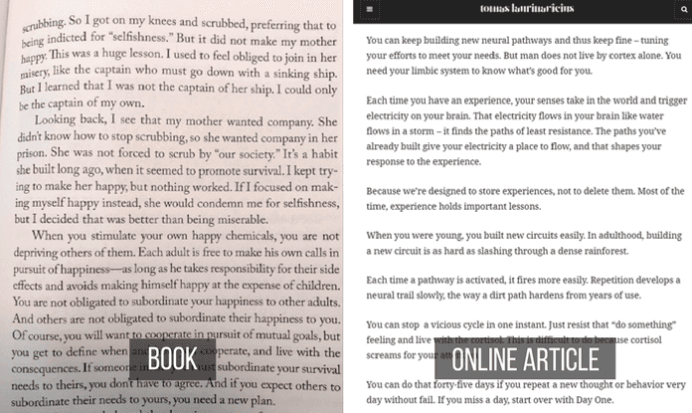It’s happened to us all at some time – you, I, your colleagues, even the writer you most admire. Blunders are as common in copywriting as in any other profession that requires human input.
But that doesn’t mean they are welcome – or unavoidable. Below I have listed seven unfortunate copywriting blunders that could happen to anyone and explained just why they are so harmful.

Credit: Wikimedia
Strangling your copy
Whether it’s to showcase your copywriting agency, sports blog, or ecommerce business, the way your copy looks on your website is super important. Many sites are guilty of using newspaper-esque multi-column layouts. Online copy is not the same as its print cousin; readers consume the two mediums in different ways.
Replicating a typical print format on your website doesn’t give you the credibility afforded to a paper – it strangles it. It detracts your readers’ attention from the content by presenting it in a way that they aren’t used to seeing online.
Opinions vary on whether presenting your text in columns is a mistake. Same say let it breathe by using a single column that allows the copy to fill the width of the page, while others find text to be more readable when it’s formatted with a visual element, like a sidebar, photo, menu, etc. in a second column. If you choose to use two columns, make the text column the wider of the two, which can help reduce the need for excessive scrolling. enabling your readers to digest it more easily.
Using really, really, really long subheadings
We’re all guilty of making blunders with our copywriting, but stretching out your titles is a particularly damaging one. You have such little time to catch your reader’s’ attention that you can’t afford to waste any space. Just 20% of users will read beyond your title.
Being overly lengthy contradicts the purpose of your titles: to summarize the content in a way that’s snappy and digestible for your readers. CoSchedule’s Headline Analyzer is a great way to check whether your titles are too long. It gives you a rating out of 100, plus tips on how you can make your titles more attention-grabbing.
Long, clunky paragraphs
It’s not just in your titles that you should prize brevity. Length can be a gift or a curse to your copywriting. Here’s how to make it the former.
Column usage isn’t the only way that online copywriting differs from print. Paragraph presentation has also changed. This is a lesson you must apply to your copywriting. Observe the example below:

Credit: SmartBlogger
As you can see, the online article has much shorter paragraphs with plenty of white space. This breaks up the copy and make it easier to digest.
Formatting your online copywriting like a novel is a major blunder. To keep your readers engaged with your content, keep your paragraphs short, varied, and uncluttered.
SPAG mistakes
This is the most unforgivable blunder. Not because you should know how to spell words and use grammar correctly (we all make this blunder at some stage), but because there are tools that are designed to spot your spelling, punctuation, and grammar (SPAG) mistakes.
Grammarly is the most widely known and used of these tools.
Adding it to your Windows browser means you can review each piece of copy that you are adding to your site. On Windows devices, it also syncs with Word, which means that if you are a professional copywriter, you can use it to check your work before you submit it to your clients.
Whatever your vocation, copy is important to your audience, and no blunder makes you look more foolish than poor SPAG.
Being unique isn’t the same as being original
If you own an enterprise ecommerce store, you may have mountains of content on your site. Writing every piece from scratch is time-consuming and creatively draining. But to address this and avoid content duplication, certain apps can help create unique content for you — meaning that you can just go in and add the final flourish to tip it over into originality.
ChatGPT-AI Product Descriptions, an app available through the online store builder Shopify, generates SEO-friendly, unique product descriptions. This can be helpful if you need to produce a number of descriptions quickly.
However, it is still a faux pas to pass too much responsibility to content generators.
They are, by their nature, inhuman, and there will be times when the human touch, personality, and originality of your voice is needed. Content generators will take you a fair way along the journey of mass copy production for your site, but they are a time-saving aid and not a replacement for your own original work.
Wrapping your call to action in nuance
Nuance is sleek, it’s elegant, it makes you rock back in your chair and bask in your intellectual prowess. Nuance in copywriting isn’t clever; it’s downright stupid.
In copywriting, your call to action is your tool to persuade your readers to do the thing your copy has set out to do – copywriting is, after all, the art of writing copy that inspires your readers to complete an action.
Using nuance in your call to action lessens the chances of your readers acting how you want them to. Be persuasive, clear, and direct.
Writing for social media alone
Twitter is a wonderful medium of conversation. It’s reactive, concise, and full of opinions: all qualities that make for good copywriting. However, while good copywriting shares traits with social media, the two mediums are not the same.
Social media is something that you can use to promote your content, but you shouldn’t use its conventions as a template for how you write. It is a very serious blunder to design your copy purely for social media and make it into a glorified Facebook post.
Instead, be aware of the benefits of social media (such as shareability) and let this inform your writing by taking note of what your audience is talking about.
You can then upload your copy with a call to action that acknowledges the unique traits of the social media platform that you are posting to, giving you the benefit of good copy that’s shareable – a win-win situation.
We all make mistakes. Copywriters all make blunders from time to time, and while you shouldn’t be ashamed about making them, you also shouldn’t shy away from the practices that can help you avoid them. What are your thoughts? We’d love to hear your comments.
About the Author
 Victoria Greene is an ecommerce specialist and freelance writer. On her blog, Victoria Ecommerce, she shares tips on ecommerce and how copywriters can fine tune their skills. She is passionate about using her experience to help other professionals grow as writers.
Victoria Greene is an ecommerce specialist and freelance writer. On her blog, Victoria Ecommerce, she shares tips on ecommerce and how copywriters can fine tune their skills. She is passionate about using her experience to help other professionals grow as writers.







